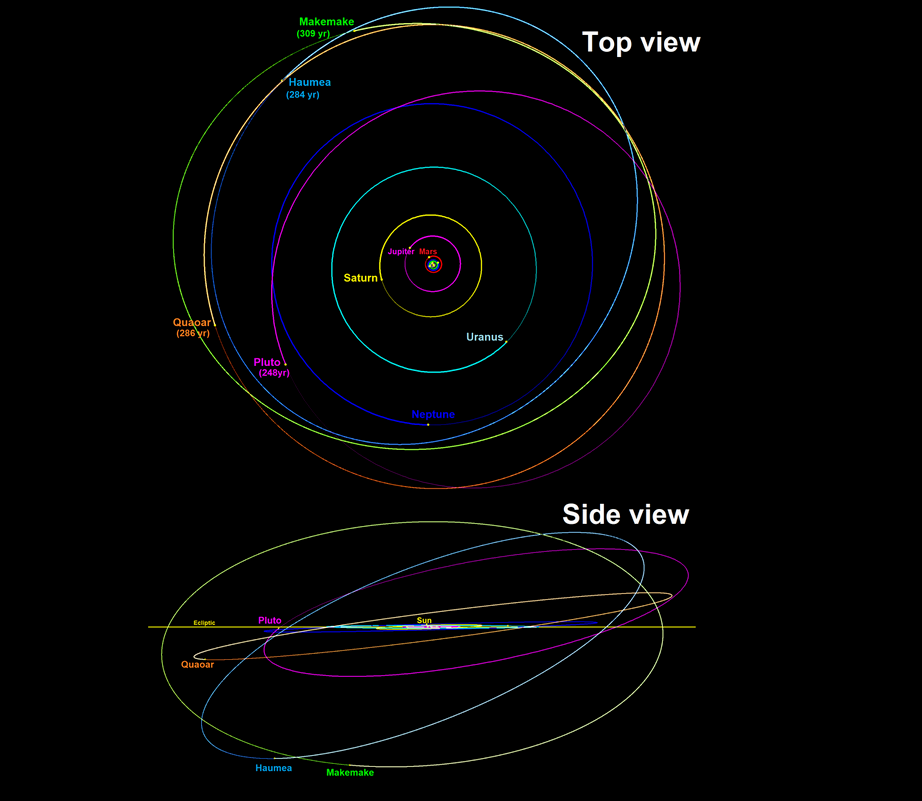
It only takes a glimpse into the night sky to realize our closest neighbor is the Moon, our own natural satellite. Traveling a distance of roughly 240,000 miles (386,400 kilometers) it takes around 3 days to make a one way journey to the Moon. The planets of our solar system are much further away, some more so than others so dwarf planets like Makemake take a long time to reach.
What Is Makemake?
Beyond Neptune in our solar system is a donut-shaped region of icy bodies known as the Kuiper Belt. This region is home to several so-called dwarf planets such as Eris Haumea and of course the subject of our article, Makemake.
The most famous dwarf planet in our solar system is Pluto which for years was considered the ninth planet but has since been downgraded. Makemake is the second largest object in the Kuiper Belt after Eris.
It was in fact the discovery of Makemake and Eris that would cause the International Astronomical Union to rethink what it means to be a planet. Three basic rules were laid out to define what a planet was and all of them must be met to meet the definition. These are:
- The object must orbit the sun
- It must be large enough to be rounded by its own gravity
- It must have cleared the neighborhood around its orbit
If any prospective planet does not meet all three then it falls into the Dwarf planet category. Essentially if Makemake and Eris had remained undiscovered Pluto may still be considered a planet although probably still a disputed one.
Distance from Earth
Makemake orbits the Sun at a different rate than Earth so at different times the two planets can be separated by vastly differing distances. They range from between 7 – 8 billion kilometers apart roughly depending on their respective orbits. The next time Earth and Makemake will be at their closest is estimated to be June 11th 2100.
Distance from the Sun
A relatively new discovery Makemake has been sitting 45.8 astronomical units (AU) from the Sun for billions of years unbeknownst to us on Earth. Placing that in context 1 AU is equal to the distance between the Sun and the Earth so Makemake is over 45 times further away from the Sun than our own planet is.

In non-astronomical terms 45.8 AU is equivalent to 4,253,000,000 miles (6,847,000,000 kilometers) on average that Makemake orbits from the Sun. Its orbit is not perfectly circular however so it can be both closer and further away than this average depending on where it is in its journey around the Sun.
How Long Does Makemake Take to Go Around the Sun?
An average distance of 4.253 billion miles from the Sun, Makemake takes a long path around our solar system’s only star. Its orbital period takes roughly 305 Earth years to complete a circuit around the Sun meaning that the last time this dwarf planet was in the same area of the solar system as it is in 2023 some interesting things were happening in history:
- New Orleans was being founded
- The Pirate Blackbeard was blockading the port of Charleston, South Carolina
- Voltaire’s first play premiered in Paris
- The Holy Roman Empire, Great Britain, Dutch Republic and France declare war on Spain
Makemake’s Structure
This is a small dwarf planet with a radius of roughly 444 miles, about 1/9th that of the planet Earth. Like most of the bodies in the Kuiper belt it formed from gas and dust being pulled in by gravity. Due to its size and vast distance from us we can not see many details of Makemake although its surface appears a reddish-brown color.
It is thought that it might be similar to fellow Dwarf planet Pluto. Scientists have been able to detect the likely presence of pellets of frozen methane and ethane. These pellets may be as big as half an inch in diameter. And they likely cover the surface of Makemake.
Atmosphere
Again Makemake is very far away and small so it is hard to be certain but scientists think that it may have at least a thin atmosphere. It may only really form when Makemake is at its closest to the Sun and it would consist of largely nitrogen.
Magnetosphere
As we have not yet had the chance to get close to this distant dwarf planet we can not be certain if it has a magnetosphere of any kind.
Does Makemake Have Moons?
Despite being so small, Makemake does have one known moon nicknamed MK2 although its official designation is S/2015 (136472) 1. It is apparently hard to see due to its small size but it does orbit roughly 13,000 miles from Makemake and has an estimated radius of just 50 miles.
History of the Observation of Makemake
Makemake is so far away from earth that unlike 7 of our solar system’s planets we can not see it with the naked eye. Even with the advent of telescopes it would still take hundreds of years to first image and then discover the existence of Makemake.

It was a team made up of Michael E. Brown, Chad Trujillo, and David Rabinowitz who were reviewing images captured on October 21st 2003 using the 1.2 m Samuel Oschin Schmidt telescope at Palomar Observatory, California. It was over a year after the images were taken that this group on January 5th 2005 discovered the presence of Makemake as well as other planetary objects such as Eris (same day) and Haumea (found 2 days earlier).
The reason Makemake was not immediately identified is because it was moving too slowly. The software used would not detect movement slower than 1.5 arcseconds per hour so although Makemake was moving across the sky this was not flagged.
The team did not immediately report their findings as they wanted to observe more about the potential orbit before going public. On July 27th 2005 however a Spanish team announced the discovery of Haumea which led the group to announce their other two discoveries at the risk of being scooped yet again by the team from Spain.
Interestingly, Makemake was recorded on several occasions before its actual discovery on photographic plates. It was not until experts reviewed older plates in search of potential information for the discovery that they noticed its presence. Digitized survey plates from Palomar Observatory showed Makemake captured on January 29th 1955 and May 1st 1998.
It is the brightest trans-Neptunian object after Pluto so technically would have been bright enough to have been seen by Clyde Tombaugh’s 1934 search for objects beyond Neptune. At the time however, conditions and its position in the night sky were such that it would have been drowned out by a dense background of stars.
Originally designated 2005 FY9 and codenamed Easter Bunny due to its discovery close to that Christian holiday, Makemake like many other notable bodies in space was named for a deity. In this case the name comes from the creator deity of the native peoples of Easter Island. The Rapa Nui worshiped the god Makemake as the creator of humanity and god of fertility.
Space Exploration
In May of 2020 the New Horizons spacecraft which did a flyby of Pluto was able to make some observations of Makemake. Despite being further away from Makemake than it was from its own start point on Earth it was able to observe things that we could not hope to observe from our own planet.

How Long Does It Take to Get to Makemake
There have been multiple proposed projects to try and make a flyby of Makemake and further exploration of the Kuiper belt. At present however none are planned to take place in the near future. It is estimated that it would take around 16 years using a Jupiter gravity assist to make the journey to Makemake for a flyby.
If we wanted to try and enter orbit around Makemake for in depth research the journey time would be massively increased. This is because changing speed in the vacuum of space is difficult and to be captured in orbit requires that we approach the planet at lower speeds.
Final Thoughts
Makemake sits far away in our solar system traveling around the Sun with a 305 Earth year orbital period. Billions of miles from Earth it is estimated it would take almost 16 years to send a mission for a close flyby of this dwarf planet.
